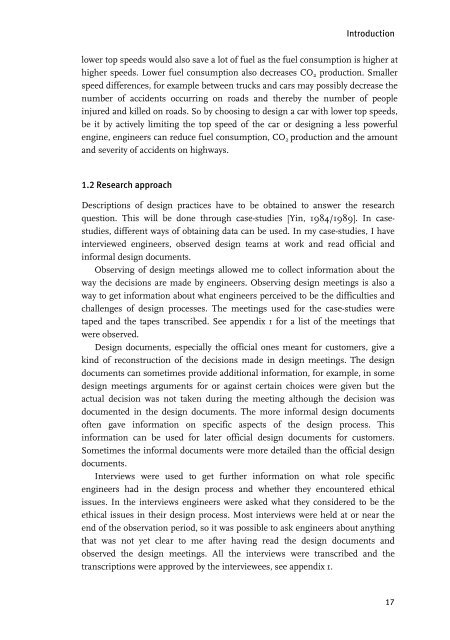Ethical issues in engineering design - 3TU.Centre for Ethics and ...
Ethical issues in engineering design - 3TU.Centre for Ethics and ...
Ethical issues in engineering design - 3TU.Centre for Ethics and ...
Create successful ePaper yourself
Turn your PDF publications into a flip-book with our unique Google optimized e-Paper software.
Introduction<br />
lower top speeds would also save a lot of fuel as the fuel consumption is higher at<br />
higher speeds. Lower fuel consumption also decreases CO2 production. Smaller<br />
speed differences, <strong>for</strong> example between trucks <strong>and</strong> cars may possibly decrease the<br />
number of accidents occurr<strong>in</strong>g on roads <strong>and</strong> thereby the number of people<br />
<strong>in</strong>jured <strong>and</strong> killed on roads. So by choos<strong>in</strong>g to <strong>design</strong> a car with lower top speeds,<br />
be it by actively limit<strong>in</strong>g the top speed of the car or <strong>design</strong><strong>in</strong>g a less powerful<br />
eng<strong>in</strong>e, eng<strong>in</strong>eers can reduce fuel consumption, CO2 production <strong>and</strong> the amount<br />
<strong>and</strong> severity of accidents on highways.<br />
1.2 Research approach<br />
Descriptions of <strong>design</strong> practices have to be obta<strong>in</strong>ed to answer the research<br />
question. This will be done through case-studies [Y<strong>in</strong>, 1984/1989]. In casestudies,<br />
different ways of obta<strong>in</strong><strong>in</strong>g data can be used. In my case-studies, I have<br />
<strong>in</strong>terviewed eng<strong>in</strong>eers, observed <strong>design</strong> teams at work <strong>and</strong> read official <strong>and</strong><br />
<strong>in</strong><strong>for</strong>mal <strong>design</strong> documents.<br />
Observ<strong>in</strong>g of <strong>design</strong> meet<strong>in</strong>gs allowed me to collect <strong>in</strong><strong>for</strong>mation about the<br />
way the decisions are made by eng<strong>in</strong>eers. Observ<strong>in</strong>g <strong>design</strong> meet<strong>in</strong>gs is also a<br />
way to get <strong>in</strong><strong>for</strong>mation about what eng<strong>in</strong>eers perceived to be the difficulties <strong>and</strong><br />
challenges of <strong>design</strong> processes. The meet<strong>in</strong>gs used <strong>for</strong> the case-studies were<br />
taped <strong>and</strong> the tapes transcribed. See appendix 1 <strong>for</strong> a list of the meet<strong>in</strong>gs that<br />
were observed.<br />
Design documents, especially the official ones meant <strong>for</strong> customers, give a<br />
k<strong>in</strong>d of reconstruction of the decisions made <strong>in</strong> <strong>design</strong> meet<strong>in</strong>gs. The <strong>design</strong><br />
documents can sometimes provide additional <strong>in</strong><strong>for</strong>mation, <strong>for</strong> example, <strong>in</strong> some<br />
<strong>design</strong> meet<strong>in</strong>gs arguments <strong>for</strong> or aga<strong>in</strong>st certa<strong>in</strong> choices were given but the<br />
actual decision was not taken dur<strong>in</strong>g the meet<strong>in</strong>g although the decision was<br />
documented <strong>in</strong> the <strong>design</strong> documents. The more <strong>in</strong><strong>for</strong>mal <strong>design</strong> documents<br />
often gave <strong>in</strong><strong>for</strong>mation on specific aspects of the <strong>design</strong> process. This<br />
<strong>in</strong><strong>for</strong>mation can be used <strong>for</strong> later official <strong>design</strong> documents <strong>for</strong> customers.<br />
Sometimes the <strong>in</strong><strong>for</strong>mal documents were more detailed than the official <strong>design</strong><br />
documents.<br />
Interviews were used to get further <strong>in</strong><strong>for</strong>mation on what role specific<br />
eng<strong>in</strong>eers had <strong>in</strong> the <strong>design</strong> process <strong>and</strong> whether they encountered ethical<br />
<strong>issues</strong>. In the <strong>in</strong>terviews eng<strong>in</strong>eers were asked what they considered to be the<br />
ethical <strong>issues</strong> <strong>in</strong> their <strong>design</strong> process. Most <strong>in</strong>terviews were held at or near the<br />
end of the observation period, so it was possible to ask eng<strong>in</strong>eers about anyth<strong>in</strong>g<br />
that was not yet clear to me after hav<strong>in</strong>g read the <strong>design</strong> documents <strong>and</strong><br />
observed the <strong>design</strong> meet<strong>in</strong>gs. All the <strong>in</strong>terviews were transcribed <strong>and</strong> the<br />
transcriptions were approved by the <strong>in</strong>terviewees, see appendix 1.<br />
17



